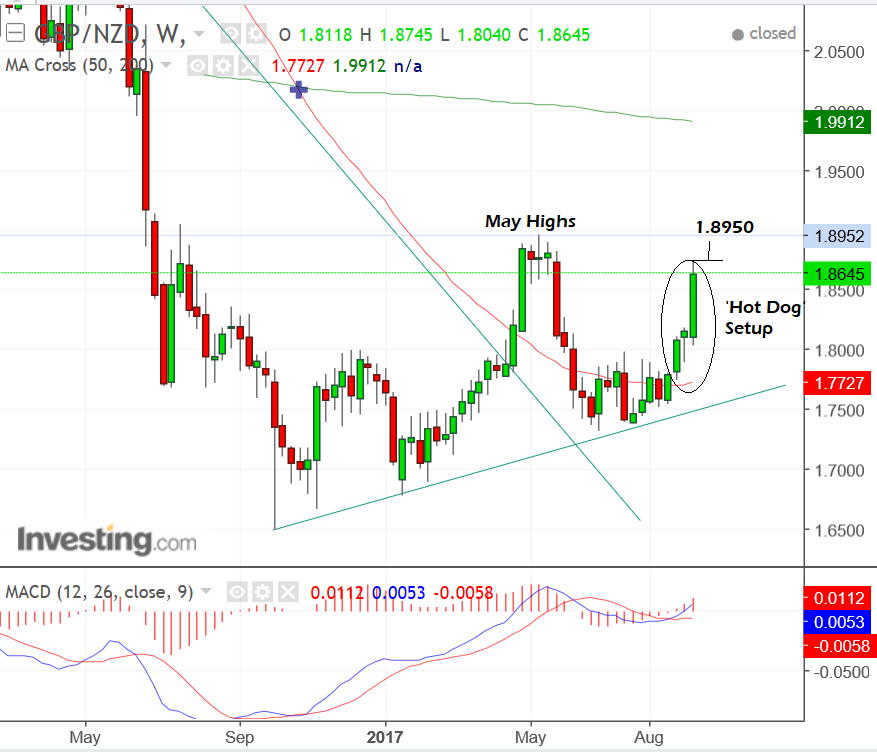Pound / New Zealand Week-Ahead: 'Hot Dog' Setup Identified on the Charts

Our technical studies suggest the Pound can rise further against the New Zealand Dollar in the near-term but we also identify some key events on the calendar that might sway direction.
The Pound drove the Pound-to-New Zealand Dollar exchange rate higher in the previous week, as there was little data to impact on the New Zealand Dollar and several events which pushed up the Pound.
The release of higher-than-expected inflation data which showed prices rose 2.9% in August started Sterling's rally which accelerated after it was revealed the Bank of England was looking to raise UK interest rates in the near-future.
GBP/NZD has risen from the mid-1.70s to the mid 1.80s in a matter of days, and the strong rally will probably continue.
The chart is showing a bullish continuation pattern called a 'Hot Dog' (circled) which shares many of the characteristics of the ADX Continuation Strategy, and indicates there is a high probability of more upside to at least the 1.8950 level of the May highs.

The Hot Dog is formed of three days, the first and third of which are always long, strong up days and the second composed of a small day which can fit at least twice inside the bodies of the first and third days.
The MACD momentum indicator is above the zero-line, indicating the trend is probably up.
A break above Friday's 1.8745 highs would confirm a continuation of the trend higher, to a probable target at 1.8950.
Data and Events to Watch for the New Zealand Dollar
The week ahead promises to have more data for Kiwi traders to focus on than the previous quiet week.
"For the New Zealand dollar, second quarter GDP, another dairy auction and the upcoming election on September 23rd will be the main focus in the coming week," says BK Asset Management's Kathy Lien.
Unfortunately for the Kiwi, the main even which is the election on the 23rd is likely to be bearish for the currency whatever the outcome, as we have already explained in several reports on PSL.
The Reserve Bank of New Zealand has no immediate plans to raise interest rates or reduce stimulus, sticking to its "lower for longer" strategy, which contrasts with the Fed, ECB, and BOE who are all set to tighten policy and increase rates in the foreseeable future.
"Next week’s second-quarter GDP report could be better but the RBNZ’s generally cautious outlook could continue to cast a dark cloud on the currency," concluded Lien.
The Global Dairy Auction at which the price is fixed for major dairy products, which constitute the largest sector of New Zealand exports, is scheduled for Tuesday, September 19 in the afternoon.
GDP data will be released at 23.45 on Wednesday, September 17.
Get up to 5% more foreign exchange by using a specialist provider by getting closer to the real market rate and avoid the gaping spreads charged by your bank for international payments. Learn more here.
Data, News, and Events for the Pound
The Bank of England's Mark Carney will be speaking at 16.00 on Monday, September 16, in Washington DC.
With Bank of England policy being the predominant driver of Sterling at present, the comments will be closely followed for any further clarification of policy trajectory.
He is unlikely to deliver a radically different message with regards to UK monetary policy to the message which came out at Thursday's policy meeting.
He will also avoid contradicting his comments made to a press pool hours after the event in which he indicated he is part of that group of policy-makers that believe an interest rate rise in the near-future is necessary.
There is the chance that he might push back against the recent market assumption that rates will be raised in November which would be negative for the Pound, but such a move would be too risky at this stage as it would certainly cloud the picture with regards to monetary policy.
The Bank's message must be clear and unanimous in scope at this juncture, and we doubt Carney would compromise with any message other than interest rates are to rise in the near-future.
Data-wise, retail sales out on Wednesday, September 20 at 09.30 BST, will provide fresh insights on consumption trends.
It is forecast to rise 1.1% year-on-year in August (from 1.3% previously) and Core is expected to rise 1.3% from 1.5% a year ago.
The recent rise in the number of people in work, "should provide some support to consumer spending, with the jobless rate falling to its lowest since 1975," said IHS Markit's Principle Economist Bernard Aw.
"However, wage growth remains stubbornly low despite the hiring surge, which could continue to weigh on household spending," he added.
A beat on expectation should reinforce the fresh positive stance adopted by markets with regards to Sterling's outlook.
IHS Markit's Household Finance Index, a survey of house holders finances, out in the week ahead, could also be useful in measuring the pressure on consumers.
On the political front, all eyes will be on Prime Minister Theresa May when she delivers a major speech on the UK's Brexit stance in Florence, Italy on Friday 22.
The speech will be keenly watched by markets for signs that the UK will yield further concessions, or even creative ideas, to push Brexit talks forward.
Such an outcome would certainly be positive for Sterling which is remains weighed down by the uncertainty surrounding the Brexit process.
The speech will also provide domestic political intrigue in that the speech will be made nearly a week after Foreign Secretary Boris Johnson wrote a lengthy article for the Telegraph newspaper in which he laid out his vision for Brexit.
Some have interpreted the speech as a direct challenge to May's leadership.
We doubt this to be the case and would suggest it is rather a rallying call to the British public at a time when confidence regarding the Brexit process is low.
Indeed, a leadership challenge opens the door to fresh elections which in turn raises the spectre of a Labour party victory and the opening of a pandora's box of market-negative policies which bode ill for Sterling's long-term valuation.




